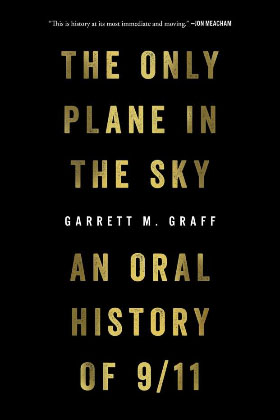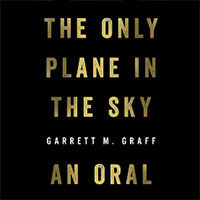— Book review by Jens Kruse —

Garrett M. Graff, a journalist and historian, has just published what is the must-read account of 9/11/01, The Only Plane in the Sky. Published one day before September 11 of 2019, it is an oral history of that momentous and horrendous day 18 years ago when 2977 people (among them 412 first responders) were killed in and near the twin towers of the World Trade Center, at the Pentagon, in Shanksville, PA and on the civilian airliners that the terrorists had turned into guided bombs. More than 3000 children lost a parent on 9/11, 6000 people were injured, and “many more would face injuries – some physical, some psychological, some eventually fatal – stemming from the recovery work” (xix).
The book is based on more than 500 oral histories conducted by the author and by many other journalists and historians. These sources are meticulously listed in an appendix.
In the body of the book Graff leads us through the minutes and hours of that long day by weaving together the voices of those 500 oral histories starting with the beginning of that Tuesday, a day that voices describe as “one of the most beautiful days of the year,” “a gorgeous blue,” and “cerulean blue” (10 and 11), a day on which, early in the morning, we hear Mike Tuohey, a ticket agent at Portland International Jetport, say: “Mr. Atta, if you don’t go now, you will miss your plane” (13).
Graff captures the progression of that day in 63 chapters, which usually begin with a scene-setting introduction by the author and then use a collage of voices to evoke that scene, that moment. A sampling of chapter titles might give you a sense of the progression of the story-telling through these voices:
- “Tuesday Begins;”
- “The Hijackings;”
- “The First Plane;”
- “The Second Plane;”
- “Jumping;”
- “The First Collapse;”
- “Airborne Somewhere over the Plains;”
- “In the Oval Office;”
- “The Day Ends.”
To give a sense of how Graff constructs his chapters I will give an extended excerpt from the chapter “The Fourth Crash”:
In the final minutes of United Airlines Flight 93, passengers and crew used the plane’s in-seat Airfones to call friends, family and airline operators to communicate about the hijacking. A few minutes before 10 a.m., United Flight 93 passenger Edward Felt, a 41-year-old, married father of two who was traveling as part of his job as a computer engineer for BEA Systems, called 911 from the plane and reached emergency dispatcher John Shaw in Westmoreland County, Pennsylvania. It was the first tip to Pennsylvania authorities that there was trouble in the skies overhead. This is an abridged transcript of their call.
Ed Felt: “Hijacking in pro—“
John Shaw: “Excuse me?” “Hey somebody’s reporting a—“
Felt: “Hijacking in progress.”
Shaw: “Sir, I’m losing you, where are you?”
Felt: “United Flight 93.”
Shaw: “Wait a minute, wait, United flight. United Flight 93.”
Felt: “Hijacking in progress!”
Shaw: “OK, where are you? Where are you?”
Felt: “I’m in the bathroom, United Flight 93.”
Shaw: “OK, where are you?”
Felt: “I don’t know.”
Shaw: “Where are you?”
Felt: “I don’t know where the plane is.”
This excerpt may not be fully representative because most chapters do not reproduce extended dialogue but assemble many utterances into a multi-voiced evocation of a moment or a scene. (In order to give a fuller flavor of these chapters, at the end of this review I will provide a link to an extended excerpt from his book that Graff published in Politico Magazine on September 5, 2019.)
The end of the “Epilogue” of this book ends with these voices:
“I go down to the ceremony each year, and I go down to the ceremony for the guy who died between my legs.”
“ I don’t think there’s a day that goes by that I haven’t thought about the events of September 11th.”
“We survive, we do our daily things, but you are always part of 9/11” (all page 425).”
None of these quotes and excerpts fully evoke the power of this book. One has to become immersed in the cumulative progression of voices and accounts narrating this terrible day. One might think that an oral history would read like something auditory, but my experience of this book was profoundly visual, scenic, cinematic.
Graff’s oral history of this day runs to 425 text pages, but I read The Only Plane in the Sky in two sittings. I could not put it down. It is absolutely riveting.
P.S. The excerpt from this book referenced in the body of this review can be found here: www.politico.com/magazine/story/2019/09/05/911-oral-history-flight-93-book-excerpt-228001
The Only Plane in the Sky. An Oral History of 9/11. (New York: Avid Reader Press, 2019) can be checked out from the Orcas Library. It is available through Darvill’s Bookstore.
**If you are reading theOrcasonian for free, thank your fellow islanders. If you would like to support theOrcasonian CLICK HERE to set your modestly-priced, voluntary subscription. Otherwise, no worries; we’re happy to share with you.**







